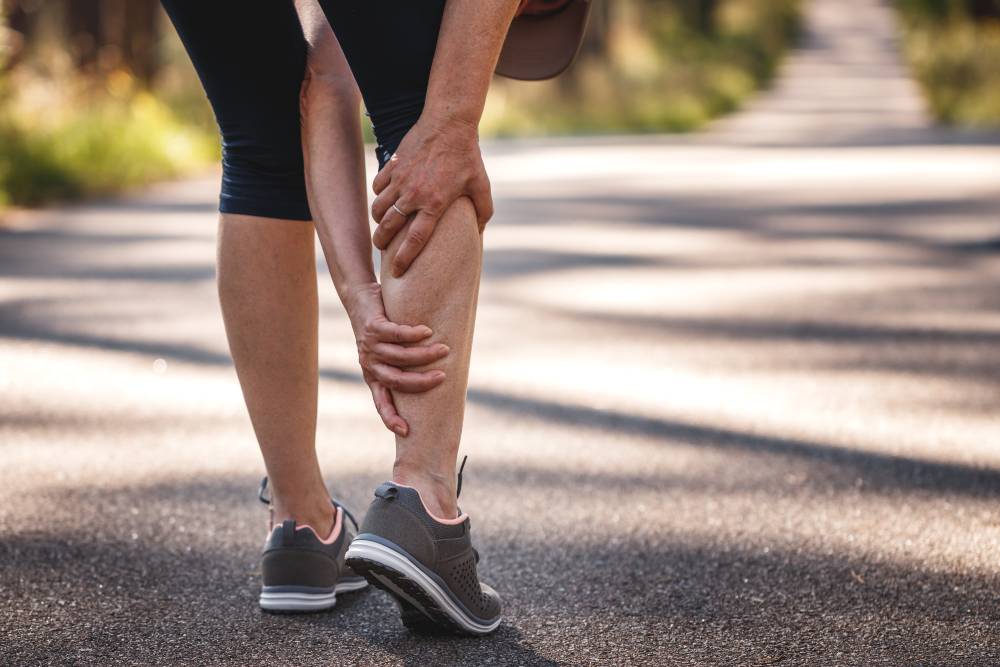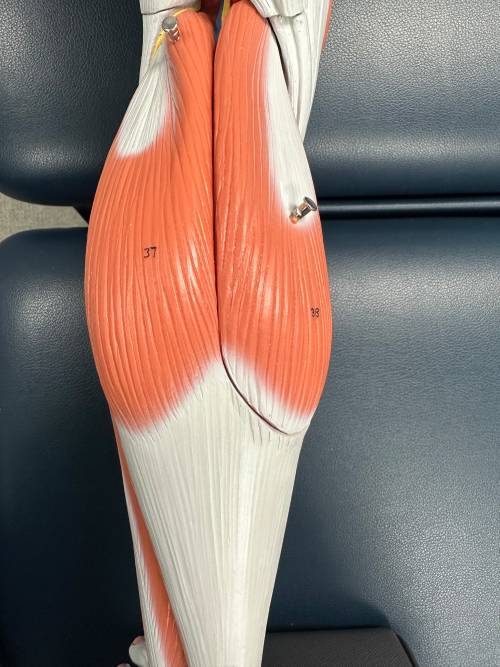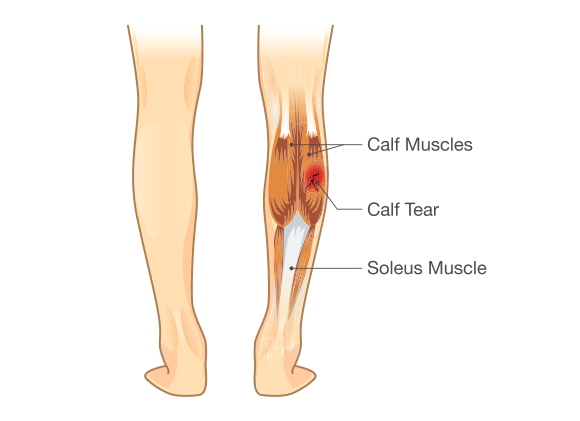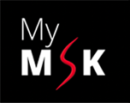
Calf muscle strains are one of the most common injuries in sports, such as sprinting, soccer, tennis, and athletics.
The calf muscles are usually strained when a person, standing still, suddenly jumps or sprints. Pivoting movements, running back and forth, stopping suddenly are movements also associated with calf muscle strains.
Depending on the severity of the injury, calf muscles simply be strained or can even tear.
Calf Muscle Anatomy

Located at the back of the leg, the calf is made up of two muscles, gastrocnemius and soleus.
- Gastrocnemius – the main muscle of the calf, consisting of two heads (parts), medial and lateral. It forms the bulge that is visible behind the knee. The more powerful of the two muscles, it is vital for jumping and running.
- Soleus – compared to gastrocnemius, this muscle is smaller, and lies beneath it. It is comparatively flatter and is also responsible for running and jumping.
The two muscles taper at the lower end, and form the Achilles tendon, by merging with tough connective tissue. This tendon then attaches to the calcaneum bone of the heel, and makes activities like walking, running etc. possible.
Calf muscle injury – what is the mechanism? How do they occur?
The two muscles, gastrocnemius and soleus, are injured when they are overstretched beyond their limit. This can happen gradually over a period (chronic), or suddenly during activity (acute).
It can occur when a person pushes their foot against the ground, to jump or sprint, such as during some sports, or even simply running.
- Gastrocnemius Injury – the gastrocnemius helps in flexing the knee, and the foot (plantar flexion i.e., movement of foot downward). It passes through two joints, the knee and ankle, and is commonly injured due to sports such as tennis and soccer, when the athlete stops or turns abruptly while running.
The medial head can become strained or even tear easily during sporting activities or sudden movements such moving the foot upwards or taking off. The most common site of injury is halfway down its length. The lateral head is less frequently injured.
- Soleus injury – the soleus muscle passes through only one joint (mono-articular), the ankle, and is also responsible for plantar flexion, its action being more powerful when the knee is flexed. It is also one of the key stabilizers of the ankle joint and is one of the muscles responsible for standing upright.
It is engaged during long-distance running to propel the athlete with force. Usually acute in presentation, soleus injury is relatively less common and more severe in terms of healing or recovery.
Symptoms of calf muscle strain or injury
Calf muscle injury can cause significant pain and have a negative impact on mobility. The symptoms vary and depend on the muscle that is affected.
Symptoms of gastrocnemius or soleus strain or injury include:
- Sudden shooting pain in the back of the leg, most commonly at the junction between the muscle and the tendon
- Trouble standing on the toes
- Pain on stretching the calf muscle (not advised!)
- Swelling, redness, and bruising may occur hours or even days after the injury
Calf muscle pain – is it a strain or a tear?

A simple calf muscle strain is a comparatively milder injury, in which some of the very small muscle fibers may be damaged or torn. While this can cause mild pain or swelling, it often heals quickly without any intensive rehabilitation. The recovery period is usually 3-4 weeks.
If the calf muscle is torn, the pain is often quite severe. The patient struggles to put their weight on the limb. Bruising, redness, and swelling are significantly more than in a strain. In some cases, there may be a palpable dent in the calf, where the muscle tear is located.
Some rare cases of calf muscle tear may lead to other complications such as deep vein thrombosis (blood clot deep inside the leg).
Grades of calf muscle injury
Calf muscle injury is often divided into three grades, which are listed as:
- Grade I – a mild form of injury, it usually happens when a muscle gets overstretched, leading to micro-tears in the fibers. Pain and slight swelling develop after one day, but mobility is not affected. The patient can participate in routine activities, and recovery is quick.
- Grade II – this is a moderate injury in terms of severity and involves partial tear of the muscle. Recovery takes longer than a grade I injury, and the person is advised to limit their activities. Pain and swelling are present, with or without bruising that develops in a few days.
- Grade III – it is the most severe form of injury, with a complete tear or rupture of the calf muscle(s). Pain is quite severe, and there is usually some bruising. Sometimes a dent or gap may be visible on the surface, and bruising may extend down to the ankle. Weight bearing can be difficult.
Diagnosis
Calf muscle strain is an injury, that needs to be carefully assessed to be diagnosed correctly. Different grades of calf injury respond to different treatments.
The doctor will take your medical history and do a physical exam.
Imaging may or may not be performed, depending on the examination and patient function
Imaging tests:
- Ultrasound –more often used to assess the gastrocnemius muscles. It is better at detecting tears in the gastrocnemius soleus junction or excluding tears in this region.
- MRI – Magnetic Resonance Imaging is the best tool to look at the soleus muscles or when there is diagnostic uncertainty, but a calf muscle tear is suspected. When the soleus muscle is suspected to be involved, MRI is the diagnostic test of choice.
Treatment options
Calf muscle injuries can have a significant impact on daily-life activities, and simple walking can prove to be very difficult
Your physician will choose the best treatment for your case, which can include:
- RICE – Rest, Ice, Compression, Elevation protocol greatly benefits grade I and grade II injuries. It is advised for the first two to three days and often speeds up muscle healing.
- Physical therapy – in mild to moderate cases of calf muscle strain, physical therapy is usually advised once the initial pain has subsided. It helps with rehabilitation of the muscles and brings back strength. It consists of various range of motion, muscle strengthening, and progressive calf stretching exercises, improving blood flow to the area, and increasing coordination.
- Immobilisation– a cast may be necessary in cases of moderate to severe injury (grades II and III). It results in immobilization and protection of the injured calf muscles.
- Medication – to aid with the pain and swelling, certain over-the-counter medicines like ibuprofen or other NSAIDs may be prescribed.
Recovery – what to expect
Grade I injury can resolve within 2-3 weeks. A strain is considerably quicker to heal than a tear.
Grade II injuries usually require anywhere from 4 to 6 weeks, longer if the soleus muscle is involved.
Grade III injuries can take 3-4 to heal properly and allow a patient to participate in sports again
Conclusion
Calf muscle injuries can be debilitating especially as they have such a significant impact on simple movements such as walking
With adequate rest, treatment, and rehabilitation, a person can return to normal muscle health and functioning. The key is to be patient during the healing process, as longer periods of immobility than presumed may be required.




